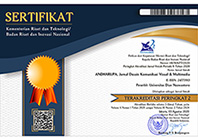Analisis Karakter “Si Korona” pada Buku Digital Kartun Edukasi Virus Corona untuk Anak-Anak di Tengah Pandemi
Abstract
Abstrak
Covid-19 (Corona Virus Disease 2019) sangat mengkawatirkan bagi sendi umat manusia saat ini di dunia. Usaha untuk menyadarkan pentingnya protokol saat new normal telah banyak dilakukan. Menyadarkan pentingnya menjaga kesehatan tentang pengetahuan virus corona dibutuhkan oleh anak-anak yang juga rentan dengan virus ini. Edukasi pengetahuan tentang virus corona diperlukan bagi anak seperti yang dilakukan oleh HIMPSI (Himpunan Psikologi Indonesia) dengan membuat kartun secara online perlu diapresiasi. Penyadaran virus corona dengan pendekatan kartun pada anak sangat menarik untuk dikaji di tengah maraknya info virus corona dalam bentuk infografis dan motion graphic ataupun iklan layanan masyarakat tentang menjaga protokol kesehatan seperti patuh pada ibu dengan 3M. Penelitian ini menggunakan metode kualitatif untuk menemukan data-data penting dalam melakukan analisis deskriptif. Melalui pendekatan karakter kartun melalui proses mimikri dan retorika visual, untuk menemukan makna karakter Si Korona. Temuan penting untuk menciptakan karakter adalah melalui proses mimikri sebagai metode untuk membangun karakter tokoh utama kartun Si Korona. Watik Ideo dan Luluk N. secara reorika visual berhasil membuat karakter Si Korona yang sederhana agar anak-anak dapat memahami tentang virus corona untuk menyadarkan pemahaman covid-19 pada anak.
Kata kunci: Edukasi Anak, Kartun, Si Korona, Virus Corona
Abstract
Covid-19 (Corona Virus Disease 2019) is very worrying for the joints of humanity today in the world. Many Covid-19 (Corona Virus Disease 2019) is very worrying for the joints of humanity today in the world. Many efforts have been made to make the protocols aware of the importance of the new normal. Awareness of the importance of maintaining health about knowledge of the coronavirus is needed by children who are also vulnerable to this virus. Education on knowledge about the coronavirus is needed for children, as done by HIMPSI (Indonesian Psychological Association) making cartoons online needs to be appreciated. Awareness of the coronavirus with a cartoon approach to children is very interesting to study amidst the rise of information on the coronavirus in the form of infographics and motion graphics or public service advertisements about maintaining health protocols such as obeying mothers with 3M. This study uses qualitative methods to find important data in conducting a descriptive analysis. Through a cartoon character approach through mimicry and visual rhetoric processes, to find the meaning of the character Si Corona. An essential finding for creating characters is through the process of mimicry as a method for building the character of the main character of the cartoon Si Corona. Watik Ideo and Luluk N. visually rhetorically succeeded in creating a simple Corona character so that children can understand the corona virus to awaken their children to an understanding of Covid-19.
Keywords: Children Education, Cartoon, Corona Virus, Si Korona
Full Text:
PDFReferences
Burks, J. A., & Burks, J. (2014). Honors College A Rhetorical Criticism of Anti-ERA Cartoons by.
Bush, L. R. (2012). More than Words: Rhetorical Devices in American Political Cartoons. University of Southern Mississippi.
Erden, B. (2009). Anger in Asterix: The metaphorical representation of anger in comics and animated films. In C. J. (J. F. & E. Urios-Aparisi (ed.)). Berlin: Mouton de Gruyte.
Fairrington, B. (2009). Drawing Cartoons & Comics FOR DUMmIES. In Wiley Publishing, Inc. 111 River St. Hoboken, NJ 07030-5774. Wiley Publishing, Inc.
Forceville, C. (2009). Non-verbal and Multimodal Metaphor in a Cognitivist Framework: Agendas for Research. (Multimodal Metaphor). Mouton de Gruyter.
Handriyotopo. (2019). Metafora dan Jejak Retorika Visual Karya Seni (1st ed.). ISI Pres Surakarta.
Hartono, A. A. P., & Adiwibawa, B. A. P. (2019). Manifestasi Citra Produk Aqua Reflection dalam Kemasan Karya Sebastian Gunawan. Citrakara, 1(1), 1–13.
Harvey, R. C. (2001). Comedy At the Juncture of Word and Image. In R. Varnum & C. T. Gibbons (Eds.), The Language of Comics: Word and Image. Jackson: University Press of Mississippi.
Heer, J., & Worcester, K. (2009). Introduction. In J. Heer & K. Worcester (Eds.), A Comics Studies Reader. Jackson: University Press of Mississippi.
Kadiasti, R., & Mukaromah, M. (2021). Perancangan Animasi tentang Sosialisasi Kembali Bersekolah bagi Anak di Pasca Pandemi menggunakan Teknik Motion Graphic. ANDHARUPA: Jurnal Desain Komunikasi Visual & Multimedia, 7(2), 352–362.
Kaindl, K. (2004). Multimodality in the translation of humour in comics. (Perspectives on Multimodality) (C. C. & In E. Ventola & M. Kaltenbacher (eds.)). John Benjamins.
Lee J. Ames. (2012). Draw 50 Famous Cartoons : The Step-by-Step Way to Draw Your Favorite Classic Cartoon Characters. Watson-Guptill Publications Inc.,U.S.
M. Keith Booker. (2010). Encyclopedia of Comic Books and Graphic Novels. Encyclopedia of Comic Books and Graphic Novels.
McCloud, S. (1993). Understanding Comics: The Invisible art. New York: HarperCollins.
Petersen. (2007). The Acoustics of Manga: Narrative erotics and the visual presence of sound. International Journal of Comic Arts (Spring 2007).
Royce, T. (. (2007). Intersemiotic complementarity: A framework for multimodal discourse analysis.(New directions in the analysis of multimedia discourse) (In T. Royce & W. Bowcher (ed.)). Routledge.
Stenglin, M., & Djonov, E. (2007). Unpacking Narrative in a Hypermedia “Artventure” for Children. Narrative Revisited.Amsterdam: John Benjamins Publishing Company.
Zahra, F. (2021). Visual Rhetoric : Framing the Methodology for Truck Visuals Through Visual Rhetoric Theory and Rhetorical Appeals. International Journal of Innovation, Creativity and Change, 15(9), 409–418.
DOI: https://doi.org/10.33633/andharupa.v8i3.5627
Article Metrics
Abstract view : 233 timesPDF - 262 times
Refbacks
- There are currently no refbacks.
indexed by:
Andharupa Journal (p-ISSN: 2477 - 2852 | e-ISSN: 2477 - 3913) is published by Dian Nuswantoro University, Semarang. This Journal is licensed under Creative Commons Attribution 4.0 International License.
























